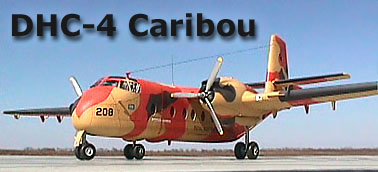 |
| The Caribou is a short takeoff and landing (STOL) utility transport built by de Havilland Aircraft of Canada,Ltd. It's primarily use is tactical airlift missions in forward battle areas where only short, unimproved airstrips are available. |
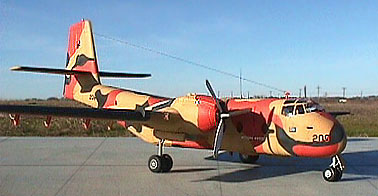 |
| It can carry 26 fully equipped paratroops or more than three tons of equipment. The Caribou's STOL capability made it particularly suitable for delivering troops, supplies, and equipment to isolated outposts in Vietnam. |
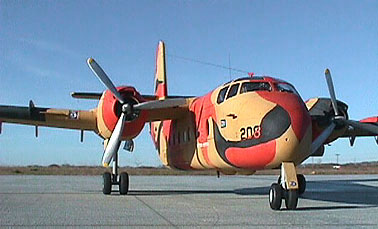 |
| The Royal Australian Air Force took delivery of it's first DHC-4 Caribou (US Army designated C-7) on the 25th of February 1964. The Caribou would replace the RAAFs aging Douglas C-47 Dakotas. |
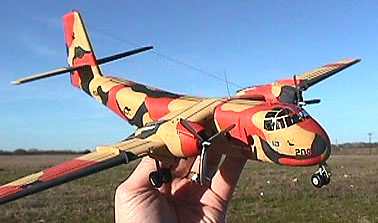 |
| A total of 33 Caribous were eventually delivered to the RAAF, and saw immediate action in Vietnam at Vung Tau with No 35 squadron. "Wallaby Airlines" carried some 600,000 passengers, lost three of its 13 aircraft in combat and had another 4 damaged. |
 |
| On May 30, 1991 the Minister of Defence announced the Caribou fleet would be reduced from 21 to 14 aircraft, and A4-164 was the first withdrawn from service in November 1992. |
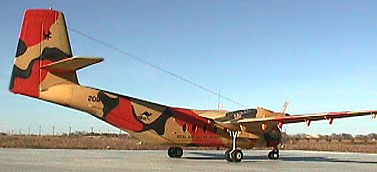 |
| The Caribou has been used by the RAAF for flare dropping missions, medical evacuation, SAR and paratroop training exercises, in addition to it's main task of airlifting of troops, civilians, supplies, ammunition, mail and food. |
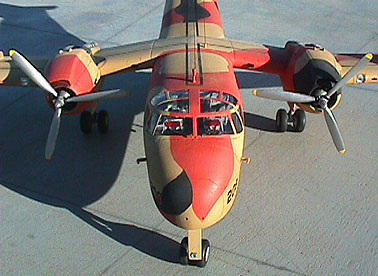 |
| Caribou A4-208 of No. 38 Squadron RAAF was painted in this scheme for camouflage trials during the mid 1980s. It was the only aircraft to carry this scheme. |
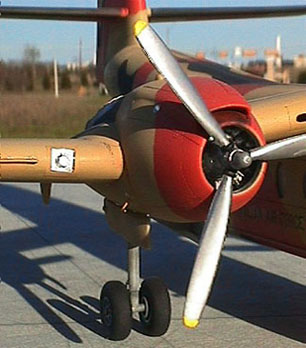 |
The two 1450hp. Pratt & Whitney R-2000 Twin Wasp radials make the Caribou capable of a maximum speed of 216mph (348km/h) at 6,500ft. with an normal cruise speed of 182mph (293km/h).
The Caribou has a range of 1,307 miles (2100km) with maximum fuel and cargo.
|
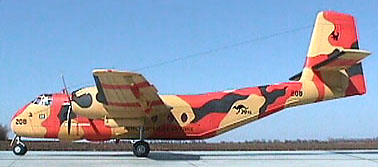 |
| This HobbyCraft kit needs help in a few areas, but overall it builds up into a nice looking Caribou. |

To see Construction Photos Click Here |
A4-208 History
|
A4-208 was delivered to the RAAF in 1964.
Flew in combat in Vietnam from 1965 - 1972.
Used for Camouflage Trials in 1987.
Withdrawn from service in 1992 (believed) and used for spare parts at Oakey Army Base.
Airlifted to Moreton Bay, Brisbane to be used as an artificial reef.
Will be looked after by Amberley scuba club.
|

Kit: Hobbycraft HC1343 |

Scale: 1/72 |
Cost:
I purchased this kit at Hobby Lobby during a 33% off sale (final price was around $24.00). At the time I thought the price was a little high but have since seen the same kit for as high as $40.00 (US). This is not a bad kit at all, but overpriced for sure. However since HobbyCraft has virtually the only Caribou on the market, they can demand whatever they want I guess.
|
Decals:
The kit provides markings for four different Caribous: a U.S. Army C-7 of the 61st Aviation Co. 1964 nicknamed "Gizmotch", a South Vietnamese Air Force Caribou C-7 of the 427th Tran. Sqn. 1973 or the first Royal Australian DHC-4 to arrive in Vietnam (A4-173) or the last to leave (A4-179).
Also provided are wingwalk stripes, prop warnings and cargo netting decal for the cargo bay windows.
My custom decals were created in Adobe Illustrator and printed to negative film. The negatives were sent to a company that creates Matro dry transfers. These are rub down transfers that worked quite well for this project. They ended up costing me about $30 (US) when all said and done. |
| After Market Parts Used: None. |
The Kit :
The kit is molded in light gray, around 70 parts depending on which version you build. All parts are flash free and molded with fine recessed panel lines. The fit is good overall with only a few trouble spots at the engine cowlings and the optional radome.
The shape of the kit is correct with the exception of the prominent steep downslope nose. The kit's nose is too shallow (see notes below on how to resolve).
The cockpit details are sparse, inaccurate and very noticeable due to the large open layout of the Caribou. Detailers will want to scratch build most of this area.
The glass parts are very clear and reasonably thin although the canopy doesn't represent the port side roof hatch, and the cargo windows aren't deep enough to fit flush with the outside of the fuselage. (see notes below)
The cargo doors are molded in the closed position and no cargo interior is provided.
This kit is very tail heavy and will need to be heavily weighted in the nose and probably also in the cargo area forward of the maingear. |
Customizing:
Interior - I extended the rear bulkhead and cut out the cockpit floor. I relocated the pilot's seats forward and added a new drop down floor aft of the seats. I used sheet stryrene to fabricate the roof access ladder, radio equipment, and other missing details. The pilots seats were detailed to include support framing, headrests, harnesses and cushions.
Glass - I decided to ignore the missing roof hatch problem as it would have been tricky to fix. The fuselage is too thick to allow the cargo window glass to align flush with the outside of the aircraft. I had to trim away each window from it's supporting plastic so it could be pushed deeper into the window openings.
Exterior - The nose was reshaped by adding several layers of sheet styrene and filled with Tamiya putty (see my construction page). Stall strips and nacelle-mounted pitot tubes were made from scrap styrene. Stretched sprue was used for antennae and brake runs. Metallic sequins and cheap gems were used to make lights. |
Research:
Squadron/Signal Publications "C-7 Caribou in action" Aircraft No 132.
Wayne (Kahuna) Buser's Caribou Tribute. |
| Special thanks to Wayne Buser and Paul Cronin for critical information and photos. |